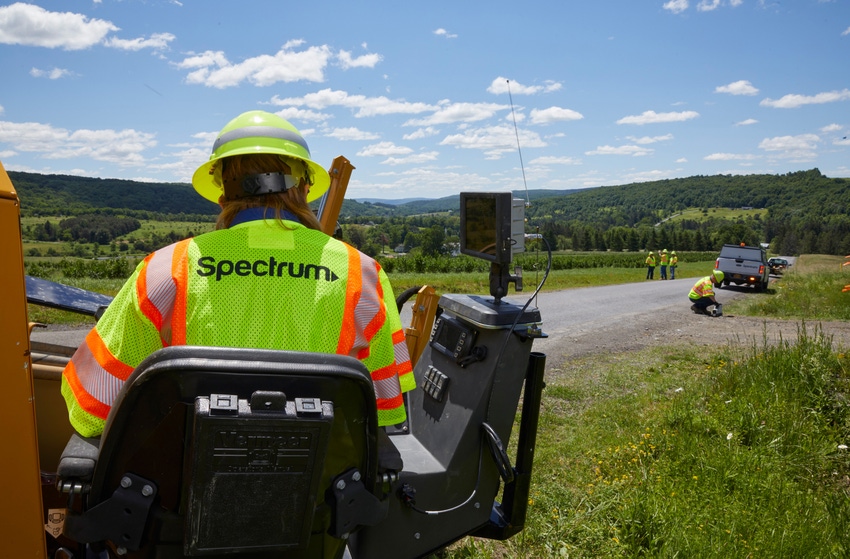Charter's more aggressive rural expansion might push out HFC upgrades
Charter has identified 300,000 nearby locations to supplement its rural broadband buildout. More near-term spending on those deployments could delay the completion of Charter's HFC upgrade to mid-2026.

Charter Communications' plan to upgrade its widely deployed hybrid fiber/coax (HFC) network could be pushed out by a few months as the company looks to redirect some dollars toward a more aggressive fiber network expansion in rural markets.
As Charter's Rural Digital Opportunity Fund (RDOF) has progressed, the operator has identified an additional 300,000 adjacent passings along the way that are not in the Census blocks that the operator originally won in the Phase I RDOF auction, Charter CFO Jessica Fischer said Friday on the company's Q3 2023 earnings call.
With those new, adjacent passings added in, Charter expects its RDOF initiative to yield about 1.3 million passings – up from the original 1 million total – over the multi-year buildout period.
Near-term tradeoffs
That expanded, more aggressive rural build could set the stage for Charter to make some near-term tradeoffs and apply some additional discipline to how it is spending capital. Also driving the matter is the fact that Charter is seeing attractive returns from the RDOF build.
Charter's rural construction effort added 78,000 passings in Q3, extending that total to 315,000. That's been paired with a service penetration rate of 34.3%, up from 32.5% in the prior quarter.
"At the 12 month mark, our rural builds are achieving nearly 50% penetrations, faster than our initial expectations," Charter CEO Chris Winfrey said.
Rural-related revenues rose to $61 million, including $27 million in residential revenues, $29 million in subsidy revenues and $5 million in "other" revenues.
New Street Research analyst Jonathan Chaplin has estimated that Charter's rural initiative is worth about $9,000 per passing, a figure that Fischer did not dispute. That would put the value of Charter's current buildout of 315,000 rural locations at $2.8 billion, which compares to the $1.6 billion (about $3,800 per passing) in capital Charter's spending on it.
Charter expects to build 300,000 new subsidized rural passings this year. Under its current run rate, Charter would be on pace to build an additional 440,000 rural subsidized passings in 2024.
More time for HFC upgrades
Charter's more aggressive stance on rural buildouts could push the completion date of Charter's HFC network upgrade/evolution plan by about six months.
Charter's original plan, which targets multi-gigabit downstream speeds and 1-gig upstream speeds at a cost of about $100 per household passed, envisioned a completion date of the end of 2025. The completion date for that buildout – which also includes upgrades to a distributed access architecture (DAA), the use of "high-splits" to beef up upstream capacity, the implementation of a new virtual cable modem termination systems (vCMTSs) and DOCSIS 4.0 deployments in a portion of Charter's HFC network – could be extended to mid-2026.
Winfrey downplayed any competitive impact such a delay would have on Charter's broadband business.
"One, it's not that material of a time difference; and two, we are competing against fiber today and our goal remains to have superior speed claims across everywhere we operate in our footprint," Winfrey said. "The six-month timeline is not going to make that much of a difference long-term."
He said a six-month push out has other operational benefits, as it will give Charter's suppliers more time to "catch up" to state-of-the-art technology that underpins DAA, high-split and DOCSIS 4.0 upgrades.
"We are looking at it [the rural buildouts and HFC upgrades] in the context of a total package to say what's an appropriate capital expense load to put against the business given where we sit," Fischer said.
She said Charter is also looking into ways to drive more visibility into the value created by its rural buildout, and expects to have more to share early next year.
Charter, Fischer noted, did explore a tracking stock for the rural efforts, but viewed that as structurally complicated. Charter also looked at a potential joint venture for the rural build, but decided that "the returns are so strong, I don't think we want to share them."
BEAD concerns, ACP hopes
And while Charter's been happy about its RDOF initiative, the operator remains leery about how much weight it will put behind the $42.45 billion Broadband Equity, Access, and Deployment (BEAD) program.
"I think it's fair to say that we were somewhat disappointed in the eventual guidelines that came out from the NTIA," Winfrey said.
States that adopt NTIA guidelines that dictate Internet tiers, pricing and labor practices "just won't be attractive states for us to bid in," he said. "It's difficult to forecast what, if any, BEAD investments will occur at this state. It will take some time to figure that out, as well as everybody else for that matter. We're not unique."
There's still time to iron out some of those wrinkles, as Charter doesn't expect any BEAD-related builds to get underway until 2025.
A more pressing near-term issue is the Affordable Connectivity Program (ACP). Winfrey said he's hopeful that the government will successfully refund the ACP after The White House submitted a formal request to Congress for $6 billion to ensure the program doesn't run short of funding next spring.
He said Charter has other tools at its disposal, including broadband programs tailored for low-income households installed before ACP, should the refunding effort fail.
About the Author(s)
You May Also Like












